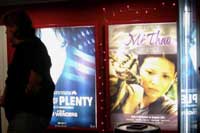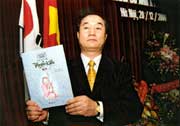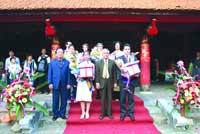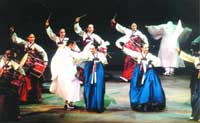|
|
|
|
|

|
|
Khmer
artist sings for a beautiful, better life
http://vietnamnews.vnagency.com.vn/showarticle.php?num=04SOC210105
(21-01-2005)
AN GIANG — The
Government issues many documents trying to educate people in ethnic
minority areas about the importance of going to school or the necessity
of saving money, but sometimes these messages can become lost due to the
culture and language barriers separating the peoples.
This is true in An
Giang Province’s O Lam Commune, where 90 per cent of the population is
Khmer and speak little, if any, Vietnamese.
One man in the
commune has taken it upon himself to not only translate these documents
for the local villagers, but to put them into a form they can better
understand — music.
When a communal
officer began distributing some documents to the people about
controlling the costs of their weddings or how to improve the health
conditions in the villages, 62-year-old musician Chau Nung asked the
officer to summarise them in a more concise manner.
He then put these
different lessons from the Government into Khmer songs accompanied by
music native to the area.
"Uncle Chau
Nung has just sung a song about thrift," explained a Khmer boy as
he was listening attentively to the artist. "It says people can not
become rich if they squander their money."
As Tran The Vinh,
former director of Tri Ton District Culture Centre, explained, the
documents were written well enough, but it was not easy to find someone
able to translate them into Khmer language.
Compounding the
problem was the fact that even if the documents were translated, the
locals would often not take them to heart if they were merely presented
in a meeting room.
But Chau Nung said
he could solve the problem. Although he lives in a solitary commune
bordering Cambodia, Nung knows Vietnamese well.
With his
contribution, Chau Nung has been recognised by communal authorities for
helping the ethnic people of O Lam raise their awareness of the law and
how to live a cultured lifestyle.
The local people
and authorities all said that Chau Nung does not do the job for money.
Chau Nung, who
learnt music entirely from his predecessors, also spends time
recollecting some Khmer songs which have nearly fallen into extinction
and sings them to children and people in the commune.
Chau Nung seemed
sad when talking about the preservation of traditional music.
"Young people
are increasingly paying less attention to the good things that are left
by our ancestors," he said.
However, as he
pointed to some gathered around him, he also said that it was important
that they be taught how to live well by whatever method possible. —
VNS
|
|

|
|
Traditional
Miscellany
(09-01-2005)
http://vietnamnews.vnagency.com.vn/showarticle.php?num=01TRA090105
Mountains
retain secrets of history, culture
by Huu Ngoc
One sunny morning last autumn, I
travelled to Hoa Binh Province, home of most of the 900,000 Muong people
who make up the third largest minority group in Viet Nam.
At the Phu Lao Commune in Lac Thuy
District some 100km south of Ha Noi, we were struck by the mixture of
past and present. It goes without saying that in a remote mountain
region such as this, it is the past that is more fascinating. Chua Tien
(Fairies Pagoda), a complex of prehistoric vestiges nestled among
soaring lime mountains, is the custodian of an ancient past and striking
cultural tradition. One of the famous sites is Dong Tien (Fairies
Grotto), where you come face to face with prehistory for the first time.
A column of sedimentary rock holds the fossilised teeth and skeleton of
a rodent that must have dwelled in the region some 100,000 years ago.
The chief interest, however, are the caves of Hao, Chim and Dong Noi and
elsewhere in the province, where artefacts have been found that bear
proof of the existence of a Mesolithic culture 10,000 or 11,000 years
ago. This culture, named Hoa Binh – Bac Son and studied by M Colani in
the 1920s, marked a revolutionary Neolithic turning point in Viet Nam,
and Southeast Asia as a whole: the transition from hunting and gathering
to agriculture and animal husbandry.
Phu Lao is also where myths and practices
of the Viet, the majority ethnic group, are found among the Muong with
local variations. This confirms the theory that the two peoples
originally belonged to the Viet-Muong ethno-linguistic group that split
in the ninth or the tenth century. The dominant cults among the Muong
are Buddhism and the worship of Mother Goddesses (tho Mau).
Moreover, the evocative shapes of stalactites and stalagmites in the
innumerable lime mountains also gave rise to animist cults, like the
worship of sacred serpents, crouching lions, Buddha’s hand fruits, and
flying dragons with milk-filled udders (symbols of fertility), etc.
Interestingly enough, the myth of the origin of the Viet people – the
union of Dragon Lord Lac Long Quan and Fairy Mother Au Co – was
reinvented to fit the local scenery, and their relics are said to exist
on Niem Mount on the Boi River, where Lac Long Quan would have rested,
or in a grotto called The Chamber where the Fairy Mother would have
retired in the evening. As well, this legend has been incorporated in
the worship of Mother Goddesses at the region’s principal temple,
where the heart and foot print of Mother Au Co and a Seven-Mile Sandal
of Father Lac Long Quan are displayed in a glass case.
Every year, on the fourth day of the
first lunar month, a big festival is held at the Fairies Pagoda. Two
days later and on the other side of the same mountain 5km away, the
Huong (Perfume) Pagoda festival will begin. This is a great opportunity
for Phu Lao to develop itself as a tourist attraction, particularly with
its proximity to the thermal springs at Kim Boi, Cuc Phuong National
Park and the ancient national capital at Hoa Lu.
For the moment, this remote Muong village
has just begun to wake up from its millennial slumber. Electricity has
come and roads have been built. Brick houses have sprung up here and
there. One of these houses belongs to Tran Dinh Luu who, like many other
simple villagers, has been earning good money raising goats in addition
to rice culture, practised by his ancestors, unchanged for centuries. -
VNS
|
|

|
http://vietnamnews.vnagency.com.vn/2004-12/24/Stories/19.htm
Saturday, December 25, 2004 |
 |
| Cover
girl: Poster of Me Thao Thoi Vang Bong in
Paris. — VNS Photo Viet Linh |
Vietnamese
film draws crowd in Paris
Despite
chilly weather in Paris and the hustle and bustle of the Christmas
season, more than 1,500 people have flocked to the Reflet Medicis
cinema in central Paris over the past two weeks to see Me Thao
Thoi Vang Bong (The Glorious Time in Me Thao, also known as Me
Thao - There Was One Time When) by director Viet Linh.
"This
is an incredible victory for such an experimental, art-house
film," the director told the Viet Nam News in an email from
Paris.
Since the
first screening on December 8, the film has attracted some 1,700
audiences to its five daily showings, two-thirds of whom are
French, Linh said.
Screening
contracts normally last for only one week and are re-signed every
Wednesday, so Linh does not know for how long the film will be
screened.
"The
number of audience members peaks during the ‘meet with the
director’ showings," Linh wrote.
Linh noted
that the film has been so successful in Paris thanks to marketing
help from friends, artists and administrative offices, as well as
coverage by both the French and Vietnamese media, especially
electronic newspapers.
The two most
surprising things to Linh are the fact that the film was
introduced on a website run by the Japanese community in Paris and
that the film ranked second among 11 films on the weekly
"most favourite film list" in Pariscope magazine (week
from December 8-14) – second only to the American film Mario
Pleine de Grace.
Apart from
Reflet Medicis cinema, Cine Rhone in Lyon and Semaphore in Nimes
have also screened the film. Another cinema in the northern suburb
of Paris has signed a contract with the Cinema Public Films
distributing company to screen the film starting on January 25,
2005.
Though
Vietnamese people account for only one third of the total
audience, they are impressed by the director.
"An old
man saw the film twice and gave me presents both times," she
said. "He thanked me for reminding him of his homeland."
The director
admitted to being "very excited" because both herself
and the distributing company were not sure how many audience
members to expect in the coming weeks.
Me Thao
Thoi Vang Bong honours a thousand years of ca tru (the
classical chamber music). The feature film is an adaptation from
Nguyen Tuan’s novel Chua Dan (Dan Pagoda), which follows
the lives of several folk artists.
The film
follows Nguyen, who believes he has nothing left to live for after
the death of his beloved wife. The dan day (three-stringed
instrument) master Truong Tam tries to cheer Nguyen by introducing
him to the ca tru singer To.
Viet Linh
invented the character of To to add romance to the film.
The three are soon trapped in a love triangle, in which Truong Tam
must decide between his love for To or his friendship with
Nguyen.
Set in the
idyllic countryside of northern Viet Nam, Me Thao Thoi Vang
Bong employs gorgeous imagery – the village well, ponds of
floating water-ferns and flat baskets full of shining yellow
silkworms.
The film won
the golden Rosa Camuna award, the top prize at the 21st Bergamo
Film Festival in Italy.
It has also
been screened at film festivals in Japan, Singapore and Belgium.
According to
Linh, the film follows other Vietnamese films screened in France,
including her own Chung Cu (Dormitory) shown during eight
weeks, Mua Oi (Guava Season) by director Dang Nhat Minh, 12
weeks; Nhung Nguoi Tho Xe (Loggers) by Vuong Duc, seven
weeks; and Vu Khuc Con Co (Song of the Storks) by Nguyen
Phan Quang Binh, two weeks. — VNS |
|
|

|
| Epic
poem Truyen Kieu introduced in Korean language |
http://vietnamnews.vnagency.com.vn/2004-12/22/Stories/24.htm
Thursday, December 23, 2004 |
 |
| Lost
in translation:
Prof Ahn Kyong Hwan holds a copy of his
Korean-language translation of Nguyen Du’s
18th century epic poem, Truyen Kieu. —
VNA/VNS Photo Tung Lam |
|
Viet Nam’s
most famous poem, Truyen Kieu (The Tale of Kieu), by the
18th century poet Nguyen Du, has been translated into Korean for
the first time.
Prof Ahn
Kyong Hwan, dean of the Department of Vietnamese Language and
Commerce at Yong San University in the Republic of Korea (RoK),
translated the work to mark the 12th anniversary of Viet Nam-RoK
diplomatic ties (December 22).
The
translation, comprising 3,254 lines of poetry and almost 1,600
notes, was introduced in Ha Noi on Monday by the Viet Nam-RoK
Friendship Association.
Last year
Ahn translated and published Nhat Ky Trong Tu (Prison
Diary), a well-known collection of poems written by late President
Ho Chi Minh.
Prof Ahn was
the first Korean to earn MA and doctorate degrees in Vietnamese
language from the National University of Social Sciences and
Humanities in HCM City.
Ahn was
awarded the Medal for the Cause of Culture and Information by the
Vietnamese Ministry of Culture and Information and the For Peace
and Friendship among Peoples Medal by the Viet Nam Union of
Friendship Organisations for his contributions to increasing
mutual understanding and co-operation between the two countries.
Truyen
Kieu is the story of a beautiful and learned young lady named
Vuong Thuy Kieu who is forced to sell herself to solve her
family’s problems. She overcomes many hardships throughout her
life in pursuit of her doomed love, Kim Trong. — VNS
|
|
|

|
|
Cultural
dialogue adds to peace, development
http://vietnamnews.vnagency.com.vn/Update/New.htm#Cultural%20dialogue%20adds%20to%20peace,%20development
HA NOI —
Delegates discussed the importance of dialogue among cultures and
civilisations and its intrinsic link to peace and sustainable
development on Monday at an international conference in Ha Noi.
The two-day
conference, which was entitled "Promotion of Dialogue among
Cultures and Civilisations for Peace and Sustainable Development:
Asia-Pacific Approaches and Experiences," was organised by the
United Nations Educational, Scientific and Cultural Organisation
(UNESCO) and the organisation’s national committee in Viet Nam.
In his opening
speech at the conference, Deputy Prime Minister Pham Gia Khiem commended
UNESCO’s efforts toward fostering discourse among different cultures.
More than 150
international guests from 30 Asia-Pacific countries considered ways of
informing politicians, professionals and social activists about the
importance of discourse among civilisations.
The conference
also outlined efforts toward innovative networking and improved
partnerships for Asia-Pacific countries.
In a message to
the conference, UNESCO General Director Koichiro Matsuura wrote that
dialogue between cultures and regions should pay due attention to the
fundamental factors that affect people’s daily lives.
Many of the
speeches at the conference highlighted exemplary approaches and
forward-looking strategies for promoting inter-cultural conversation,
especially with regards to education.
Participants
shared ideas and recommendations for networking as well as consolidating
common regional approaches.
The concept of a
"Dialogue among Civilisations" has assumed greater salience in
the face of new threats to global peace and security. Promoting a
dialogue among civilisations has attracted renewed attention at the
highest political levels throughout the world since the tragic events of
September 11, 2001, according to UNESCO. — VNS
|
|

|
 |
| Champions:
First Prize winners Qin Lifang of China (second from
left) and Renaud Heintz of France (right extreme)
receive their awards at the Temple of Literature. —
VNS Photo Viet Thanh |
http://vietnamnews.vnagency.com.vn/2004-12/16/Stories/23.htm
Friday,
December 17, 2004
Foreigners win Ha Noi writing contest
HA NOI —
Thirty six exemplary essays written about Ha Noi by international
competitors were awarded prizes on Wednesday at the Temple of
Literature.
The best
essays were selected by the organisers of the international
writing competition titled ‘Ha Noi, A Thousand Years of Culture
– The City of Peace.’
Winners were
selected for their correct answers to seven pre-selected
questions, answered in a persuasive and well-written manner.
The first
prize, worth VND20 million (US$1,300), was awarded to three
authors; Renaud Heintz from France, Qin Lifang from China and
April Dorothy Beeton from Australia.
The four
runners up, Zhong Wei Ying (China), Le Ai Tran (Vietnamese
resident in France), Vladimir Iuri (Russia) and Yamamoto Midori
(Japan), won second prizes worth VND10 million each.
The contest
also included four VND5 million third prizes and 25 consolation
prizes worth VND2 million each.
The aim of
the competition, which was open to all foreigners and overseas
Vietnamese who are interested in Ha Noi, was to strengthen
friendships between Vietnamese and the rest of the world, and to
promote dialogue and share cultural values.
The contest
hoped to contribute to global understanding and respond to the
International Decade for Culture and Peace launched by UNESCO and
the United Nations in 2001.
The deputy
head of the organising board, Trinh Yen, said that the judging
board made all efforts to select the 36 most outstanding papers of
the 3522 submitted. The contest received entries in six languages
including English, Russian, Japanese, Chinese, French and
Vietnamese by international competitors from more than 100
countries.
Yen said the
contest attracted people of all ages. The youngest to apply was an
10-year-old Indian boy and the eldest a 82-year-old Vietnamese
Canadian man.
"The
competition went far beyond simply understanding Ha Noi. It is an
exchange of friendship and sharing between human beings," he
said.
Yen said
that the judging board was pleased with the selected papers
because the winning writers did careful research and had different
but accurate approaches to the answers.
"We
were touched by the affection, respect and interest in Ha Noi
expressed in the papers, particularly those that showed the
writers’ experiences during their research into the history and
culture of the capital," Yen said.
"The
competition not only brings the culture and history of Ha Noi
closer to international friends, but also help us learn about the
culture and history of different parts of the world through the
competitors’ papers. It is a message of friendship."
The
competition is part of the Ha Noi (formerly known as Thang
Long)’s 1,000th anniversary celebrations and was launched by the
Viet Nam Federation of UNESCO Clubs in co-ordination with the
State Steering Commission for the anniversary. — VNS
|
|
|

|
Friday,
December 3, 2004
http://vietnamnews.vnagency.com.vn/2004-12/02/Stories/23.htm |
 |
| Seoul
train: Members of an RoK dance troupe perform
traditional Korean dances. — VNS File Photo |
Viet
Nam, RoK to hold weeklong festival
Viet Nam and
the Republic of Korea (RoK) will hold A Week of Friendship in Ha
Noi to commemorate the 12th year of diplomatic relations between
the two nations.
The special
event, to be held between December 6 and 14, is being planned by
the RoK government in co-ordination with the RoK embassy in Viet
Nam and the Viet Nam-Korea Friendship Association.
"The
bilateral relationship was strengthened by a visit from the RoK
president to Viet Nam in October which will promote diplomatic and
economic co-operation between the two countries," said the
RoK’s Ambassador Yoo Tae Hyun. "We also want Vietnamese
people to join the week of friendship to ensure its success."
During the
event, artists from the South Korean Opera Group will perform the
opera Whangjinie in the capital city.
Founded in
1989, the South Korean Opera Group does not only focus on Western
operas, but also hopes to invigorate and revive traditional Korean
operas.
The troupe
premiered the original Korean Opera Whangjinie in 1999 and
received favourable responses from both critics and audiences. The
opera tells the story of Whangjinie, a poet in the mid-Joseon
Dynasty who broke down social barriers to become a professional
entertainer.
The opera
will begin at 8pm on December 8 and 9 at the Ha Noi Opera House.
Three
hundred invitations will be offered at the RoK embassy before
December 6.
An
exhibition for Korean "Made in Viet Nam" products will
also be held in the Giang Vo Exhibition Centre starting December
6.
About 1,050
cosmetic, pharmaceutical and household accessory products will be
displayed during the event. Organiser hope to attract visitors to
the exhibition with an artistic programme.
Traditional
music performances will include drums, Korean operas, vessel and
traditional monk performances. The shows will begin at 6pm on
December 10 and 3pm on December 11.
Thirty
photos featuring high-ranking visits and special events during the
12 years of diplomatic relations between Viet Nam and the RoK will
also be showed at a photo exhibition, which will be open from
December 10 to 14 in the Giang Vo Exhibition Centre.
A Korean
singing contest will start at 2pm on Sunday, December 12 at the
centre. The contest will attract contestants from Korean-invested
companies.
In addition,
on December 12 the Korean embassy will announce the winners of an
essay writing contest at the Daewoo Hotel. The contest, which was
designed for Vietnamese people who want to learn more about the
RoK, was launched two months ago and received some 3,700 essay
entries, said Press Counsellor Han. — VNS
|
|
|

|
|
Culture
to benefit from open investment
http://vietnamnews.vnagency.com.vn/2004-11/01/Stories/03.htm
Tuesday, November 2, 2004
HA NOI — Though private investors have ignored non-profitable
cultural activities, they have increasingly invested in the
cultural sector since it was opened to private participation five
years ago, said the Ministry of Culture and Information.
"The
sector has succeeded in luring private investments. But, most
investors are only interested in investing in areas that fetch
profits," said Deputy Minister Dinh Quang Ngu, pointing out
disparities in private participation in different regions of the
country.
While
private participation has increased in the more profitable
printing, publishing and cultural services sectors, helping to
diversify cultural activities and products, investors interested
only in profits are threatening to destroy the country’s
traditions and customs.
"Shortcomings
in the sector persist as it still depends on subsidies. On the
other hand, problems arising from turning culture into a business
have not been fully foreseen." The deputy minister said it
was important to maintain and protect Viet Nam’s traditions.
"Lack
of policies, encouraging the good and preventing negative
phenomena from emerging in this sector, is one of the reasons for
the current situation," he said.
For the
sector’s development plan for 2010, the Ministry of Culture and
Information has proposed laying down a consistent legal framework
to ensure the rights of investors, along with granting of
preferential loans and privilege taxes. The plan, submitted last
month for Government approval, said it was a crucial task to
mobilise all social resources, and attract people from every
economic sector and social strata to invest in Viet Nam’s
culture.
The ministry
plans to mobilise 49 per cent of funds from the non-state sectors
for cultural activities, and encourage non-State agencies to
provide 40 to 60 per cent of cultural services.
Individuals,
households, and social and economic organisations all constitute
the non-state sectors.
By 2005, the
ministry plans to shift certain cultural organisations into the
non-State sectors on an experimental basis.
While
publishing houses, media, national and provincial museums and
theatres, historical and cultural relic management boards are to
be kept in the hands of the State, many art and cultural troupes
will be privatised.
In Ha Noi
and HCM City, only national cultural troupes performing tuong,
cheo, and cai luong, ballet, opera and circus are to be
kept in the hands of the State.
The State
will support one traditional art troupe in each province, and
allow new art and cultural troupes to be established by investors
from the non-State sectors.
Under the
plan, colleges training highly professional artists and art of
ethnic minorities will not be privatised.
Private art
schools for cinematography, ballet, and art will be permitted on
the condition of following the curriculum of State-run schools.
The plan also enourages foreign participation in this area.
It will also
encourage the establishment of private and joint-stock film
producing companies, cinema halls and allow import of films
approved by the State.
For the plan
to succeed, related ministries, including finance, justice,
education, and health care, have to co-operate for completing a
comprehensive law on culture, the ministry said. — VNS
|
|
|

|